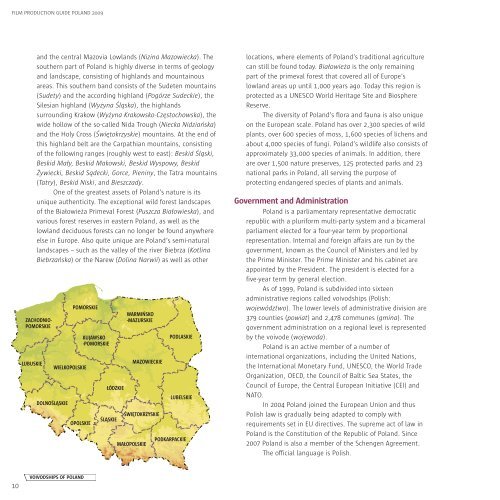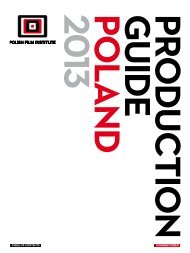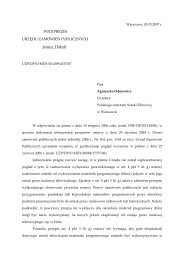Create successful ePaper yourself
Turn your PDF publications into a flip-book with our unique Google optimized e-Paper software.
FILM PRODUCTION GUIDE POLAND <strong>2009</strong><br />
0<br />
and the central Mazovia Lowlands (Nizina Mazowiecka). The<br />
southern part of <strong>Poland</strong> is highly diverse in terms of geology<br />
and landscape, consisting of highlands and mountainous<br />
areas. This southern band consists of the Sudeten mountains<br />
(Sudety) and the according highland (Pogórze Sudeckie), the<br />
Silesian highland (Wyżyna Śląska), the highlands<br />
surrounding Krakow (Wyżyna Krakowsko-Częstochowska), the<br />
wide hollow of the so-called Nida Trough (Niecka Nidziańska)<br />
and the Holy Cross (Świętokrzyskie) mountains. At the end of<br />
this highland belt are the Carpathian mountains, consisting<br />
of the following ranges (roughly west to east): Beskid Śląski,<br />
Beskid Mały, Beskid Makowski, Beskid Wyspowy, Beskid<br />
Żywiecki, Beskid Sądecki, Gorce, Pieniny, the Tatra mountains<br />
(Tatry), Beskid Niski, and Bieszczady.<br />
One of the greatest assets of <strong>Poland</strong>’s nature is its<br />
unique authenticity. The exceptional wild forest landscapes<br />
of the Białowieża Primeval Forest (Puszcza Białowieska), and<br />
various forest reserves in eastern <strong>Poland</strong>, as well as the<br />
lowland deciduous forests can no longer be found anywhere<br />
else in Europe. Also quite unique are <strong>Poland</strong>’s semi-natural<br />
landscapes – such as the valley of the river Biebrza (Kotlina<br />
Biebrzańska) or the Narew (Dolina Narwii) as well as other<br />
ZACHODNIO-<br />
POMORSKIE<br />
LUBUSKIE<br />
DOLNOŚLĄSKIE<br />
POMORSKIE<br />
WIELKOPOLSKIE<br />
OPOLSKIE<br />
voIvodSHIPS oF PoLand<br />
KUJAWSKO<br />
-POMORSKIE<br />
ŁÓDZKIE<br />
ŚLĄSKIE<br />
WARMIŃSKO<br />
-MAZURSKIE<br />
MAZOWIECKIE<br />
ŚWIĘTOKRZYSKIE<br />
MAŁOPOLSKIE<br />
PODLASKIE<br />
LUBELSKIE<br />
PODKARPACKIE<br />
locations, where elements of <strong>Poland</strong>’s traditional agriculture<br />
can still be found today. Białowieża is the only remaining<br />
part of the primeval forest that covered all of Europe’s<br />
lowland areas up until 1,000 years ago. Today this region is<br />
protected as a UNESCO World Heritage Site and Biosphere<br />
Reserve.<br />
The diversity of <strong>Poland</strong>’s flora and fauna is also unique<br />
on the European scale. <strong>Poland</strong> has over 2,300 species of wild<br />
plants, over 600 species of moss, 1,600 species of lichens and<br />
about 4,000 species of fungi. <strong>Poland</strong>’s wildlife also consists of<br />
approximately 33,000 species of animals. In addition, there<br />
are over 1,500 nature preserves, 125 protected parks and 23<br />
national parks in <strong>Poland</strong>, all serving the purpose of<br />
protecting endangered species of plants and animals.<br />
government and administration<br />
<strong>Poland</strong> is a parliamentary representative democratic<br />
republic with a pluriform multi-party system and a bicameral<br />
parliament elected for a four-year term by proportional<br />
representation. Internal and foreign affairs are run by the<br />
government, known as the Council of Ministers and led by<br />
the Prime Minister. The Prime Minister and his cabinet are<br />
appointed by the President. The president is elected for a<br />
five-year term by general election.<br />
As of 1999, <strong>Poland</strong> is subdivided into sixteen<br />
administrative regions called voivodships (Polish:<br />
województwo). The lower levels of administrative division are<br />
379 counties (powiat) and 2,478 communes (gmina). The<br />
government administration on a regional level is represented<br />
by the voivode (wojewoda).<br />
<strong>Poland</strong> is an active member of a number of<br />
international organizations, including the United Nations,<br />
the International Monetary Fund, UNESCO, the World Trade<br />
Organization, OECD, the Council of Baltic Sea States, the<br />
Council of Europe, the Central European Initiative (CEI) and<br />
NATO.<br />
In 2004 <strong>Poland</strong> joined the European Union and thus<br />
Polish law is gradually being adapted to comply with<br />
requirements set in EU directives. The supreme act of law in<br />
<strong>Poland</strong> is the Constitution of the Republic of <strong>Poland</strong>. Since<br />
2007 <strong>Poland</strong> is also a member of the Schengen Agreement.<br />
The official language is Polish.








